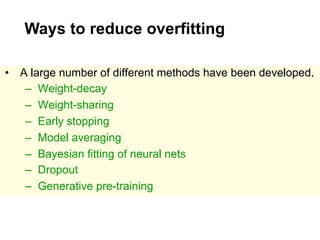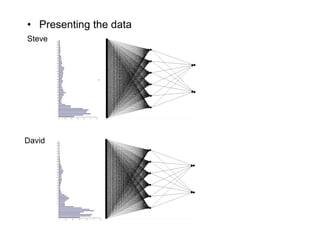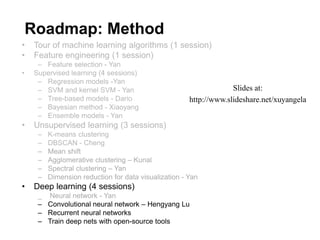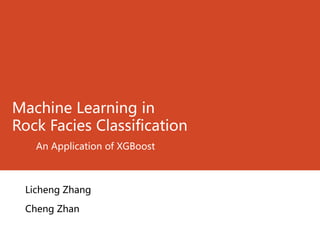Introduction to Neural Network
- 1. Yan Xu Houston Machine Learning Meetup April 8, 2017 Building an artificial neural network
- 2. Roadmap: Method • Tour of machine learning algorithms (1 session) • Feature engineering (1 session) – Feature selection - Yan • Supervised learning (4 sessions) – Regression models -Yan – SVM and kernel SVM - Yan – Tree-based models - Dario – Bayesian method - Xiaoyang – Ensemble models - Yan • Unsupervised learning (3 sessions) – K-means clustering – DBSCAN - Cheng – Mean shift – Agglomerative clustering – Kunal – Spectral clustering – Yan – Dimension reduction for data visualization - Yan • Deep learning (4 sessions) _ Neural network - Yan – Convolutional neural network – Hengyang Lu – Recurrent neural networks – Train deep nets with open-source tools Slides posted on: http://www.slideshare.net/xuyangela
- 3. Outline • Introduction • Feed forward neural network • Learning process - by Geoffrey Hinton • Overfitting issue • Voice recognition • Bonus – Machine learning in Rock Facies Classification by Cheng Zhan
- 8. What are Neural Networks? • Models of the brain and nervous system • Highly parallel – Process information much more like the brain than a serial computer • Simple principles Complex behaviours
- 9. Biological Neural Nets • Pigeons as art experts (Watanabe et al. 1995) – Experiment: • Pigeon in Skinner box • Present paintings of two different artists (e.g. Chagall / Van Gogh) • Reward for pecking when presented a particular artist (e.g. Van Gogh)
- 11. • Pigeons were able to discriminate between Van Gogh and Chagall with 95% accuracy (when presented with pictures they had been trained on) • Discrimination still 85% successful for previously unseen paintings of the artists • Pigeons do not simply memorise the pictures • They can extract and recognise patterns (the ‘style’) • They generalise from the already seen to make predictions • This is what neural networks (biological and artificial) are good at (unlike conventional computer)
- 12. • ANNs incorporate the two fundamental components of biological neural nets: 1. Neurones (nodes) 2. Synapses (weights) Artificial Vs. Biological Neural Nets
- 13. • Neurone vs. Node
- 14. • Structure of a node: • Squashing function limits node output:
- 15. • Synapse vs. weight
- 16. Feed-forward nets • Information flow is unidirectional • Data is presented to Input layer • Passed on to Hidden Layer • Passed on to Output layer • Information is distributed • Information processing is parallel Internal representation (interpretation) of data
- 17. Feeding data through the net: (1 0.25) + (0.5 (-1.5)) = 0.25 + (-0.75) = - 0.5 0.3775 1 1 5.0 e Squashing:
- 18. • Data is presented to the network in the form of activations in the input layer • Examples – Pixel intensity (for pictures) – Molecule concentrations (for artificial nose) – Share prices (for stock market prediction) • How to represent more abstract data, e.g. a name? – Choose a pattern, e.g. • 0-0-1 for “Chris” • 0-1-0 for “Becky” Data Input
- 19. •Structure •Exclusive-OR •problem •Classes with •meshed regions •Most general •region shapes •Single-Layer •Two-Layer •Three-Layer •A •A•B •B •A •A•B •B •A •A•B •B •B •A •B •A •B •A Hidden Layers: Separability
- 20. •Gradient: E[w]=[E/w0,… E/wn] •(w1,w2) •(w1+w1,w2 +w2) •w=- E[w] •wi=- E/wi Learning: Gradient Descent •Chain rule:
- 21. • How can we find the right weights? By Geoffrey Hinton, Godfather of deep learning https://www.youtube.com/watch?v=qStsskXgZq8&index =3&list=PLnnr1O8OWc6arChulXyEhNvEuZcSHv2aV https://www.youtube.com/watch?v=xfPz92B0rv8&index =4&list=PLnnr1O8OWc6arChulXyEhNvEuZcSHv2aV
- 22. Recap:
- 23. Recap:
- 24. Overfitting: The downside of using powerful models
- 25. Ways to reduce overfitting
- 26. Example: Voice Recognition • Task: Learn to discriminate between two different voices saying “Hello” • Data – Sources • Steve • David – Format • Frequency distribution (60 bins) • Analogy: cochlea
- 27. • Network architecture – Feed forward network • 60 input (one for each frequency bin) • 6 hidden • 2 output (0-1 for “Steve”, 1-0 for “David”)
- 28. • Presenting the data Steve David
- 29. • Presenting the data (untrained network) Steve David 0.43 0.26 0.73 0.55
- 30. • Calculate error Steve David 0.43 – 0 = 0.43 0.26 –1 = 0.74 0.73 – 1 = 0.27 0.55 – 0 = 0.55
- 31. • Repeat process (sweep) for all training pairs – Present data – Calculate error – Backpropagate error – Adjust weights • Repeat process multiple times
- 32. • Presenting the data (trained network) Steve David 0.01 0.99 0.99 0.01
- 33. Conclusion • Learn how artificial neural network is related to biological neural network • Feedforward neural network • How weights are learned through gradient descent • Applications
- 34. From neural network to deep learning • Gradient descent will not work for deep neural network (vanishing gradients). • More effective ways to train deep networks: • Breakthrough: Unsupervised pre-training by Geoffrey Hinton, 2006. • Deep learning via Hessian-free optimization by Martens, 2010. • On the importance of initialization and momentum in deep learning, 2013. • Massive increase in computing power and massive increase in the amount of available training data.
- 35. Roadmap: Method • Tour of machine learning algorithms (1 session) • Feature engineering (1 session) – Feature selection - Yan • Supervised learning (4 sessions) – Regression models -Yan – SVM and kernel SVM - Yan – Tree-based models - Dario – Bayesian method - Xiaoyang – Ensemble models - Yan • Unsupervised learning (3 sessions) – K-means clustering – DBSCAN - Cheng – Mean shift – Agglomerative clustering – Kunal – Spectral clustering – Yan – Dimension reduction for data visualization - Yan • Deep learning (4 sessions) _ Neural network - Yan – Convolutional neural network – Hengyang Lu – Recurrent neural networks – Train deep nets with open-source tools Slides at: http://www.slideshare.net/xuyangela
- 36. Machine Learning in Rock Facies Classification An Application of XGBoost Licheng Zhang Cheng Zhan
- 37. Thank you Machine learning in Oil and Gas Conference @ Houston, April 19-20: https://energyconferencenetwork.com/machine-learning-oil-gas-2017/ 20% off, PROMO code: HML Data Disruptors Conference, ddc (energy) @ Houston, June 14 PROMO code: PROMO: HEDS49 http://www.slideshare.net/xuyangela



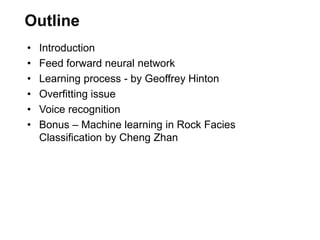
















![•Gradient:
E[w]=[E/w0,… E/wn]
•(w1,w2)
•(w1+w1,w2 +w2)
•w=- E[w]
•wi=- E/wi
Learning: Gradient Descent
•Chain rule:](https://image.slidesharecdn.com/neuralnetworks-170409031214/85/Introduction-to-Neural-Network-20-320.jpg)




